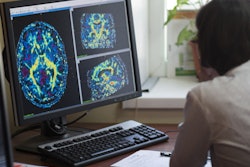
Time lost due to interruptions in the reading room can gut radiologist productivity, according to a U.S. group. They detailed the issue at their hospital in Ohio, and offered their take on how to improve workflows, in a June 27 article in Current Problems in Diagnostic Radiology.
The researchers studied the activities of pediatric radiologists affiliated with Ohio University to clarify the frequency and origin of interruptions they experience in reading rooms. They found that interruptions significantly increased the time needed to read x-rays, ultrasounds, CTs, and MRIs.
"Total interruption time nearly equaled the total time interpreting studies for radiologists," wrote corresponding author Dr. Lamya Atweh, a radiology fellow at Nationwide Children's Hospital in Columbus.
Interruptions are estimated to cost U.S. companies $588 billion a year in lost productivity, with interruptions during clinical tasks adversely impacting efficiency, accuracy, and consequently patient safety, according to the authors.
Moreover, the consultant nature of modern radiology is already susceptible to interruptions and the current global push toward increased clinical collaboration is intensifying the issue, they added.
In this study, the group sought to understand the frequency and origin of interruptions, their impact on report turnaround times, and how to plan interventions to reduce their impact.
The researchers employed quality improvement specialists to observe the activity of 13 pediatric radiologists in the general, neuroradiology, and body reading rooms at their hospital during all shifts. The radiologists were shadowed, and activities outside of interpretation time were characterized as active interruptions (disruptions initiated by the radiologist) or passive interruptions (disruptions not initiated by the radiologist).
Over 61 hours, the radiologists interpreted 561 studies, including 439 radiographs, 32 ultrasound scans, 51 MRI exams, and 39 CT scans. Thirty-one hours were observed in the main reading room, 15 hours in the neuroradiology reading room, and 15 hours in the body reading room.
The radiologists spent 52% of their time interpreting studies, 29% on active interruptions, and 18% on passive interruptions. About 50% of noninterpretive time involved in-person conversations or consults and 16% involved phone calls -- of which 67% were incoming, according to the findings.
Furthermore, the longest time period without an interruption was 20 minutes. Interruptions increased the time radiologists needed to read a study by one minute for radiography, two minutes for ultrasound, six minutes for CT, and 10 minutes for MRI, the researchers found.
"Interruptions not only cost the radiologist whatever time it took to address the interruption, but also cost additional total time to finalize the report dictation," the authors wrote.
The researchers used the results to plan, justify, and implement interventions as part of a quality improvement initiative at their hospital.
For one, they designed a new central radiology reading room equipped with sound barriers that combined the neuroradiology and body radiology reading rooms. They placed a reading room assistant at the entrance 24/7 to triage phone calls and used standardized phone call intake forms to help radiologists filter out nonurgent requests.
The group also implemented text-based communication through the hospital's electronic medical record system and a phone-based application for more efficient communication with other departments and clinicians.
In addition, imaging protocols were improved and standardized to minimize phone calls from technologists while assuring high quality image acquisition, and technologist training was increased to encourage more independence and fewer cases of interrupting the radiologist, the group wrote. Trainee rotation schedules were also improved to assure that no more than one trainee would be with a radiologist at a time.
While the researchers have yet to quantify the effects of these interventions on radiologist interruptions, anecdotal evidence suggests workflows and interruptions have improved, the authors wrote.
Ultimately, the study highlights the challenges radiologists face when managing their workflow with a high frequency of interruptions. Interpreting radiography, ultrasound, CT, and MRI exams with interruptions was quantified and shown to be less efficient, the authors wrote.
"Many interventions have been proposed and implemented, and these may be cost-effective when compared to lost productivity," Atweh and colleagues concluded.




.fFmgij6Hin.png?auto=compress%2Cformat&fit=crop&h=100&q=70&w=100)




.fFmgij6Hin.png?auto=compress%2Cformat&fit=crop&h=167&q=70&w=250)











